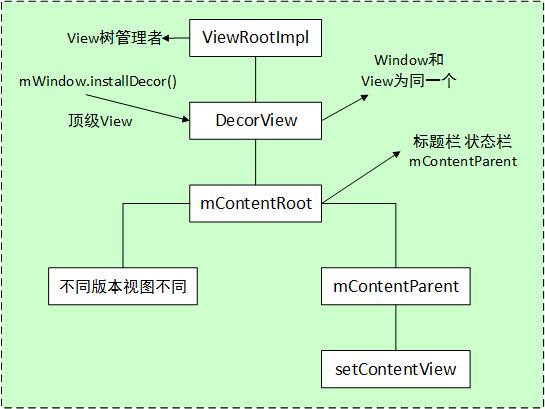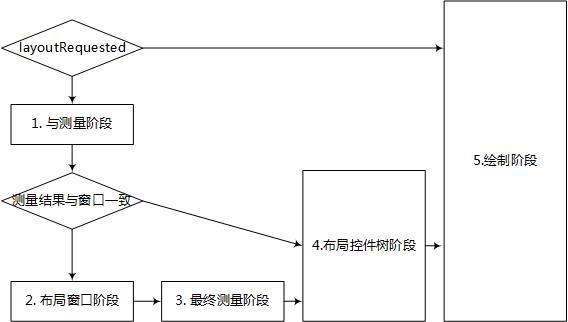1.1 Window窗口管理框架图
窗口的添加从Activity::makeVisible开始,由WindowManagerImpl委托给WindowManagerGlobal处理,WindowManagerGlobal内部的mViews、mRoots、mParams、mDyingViews分别管理窗口的试图、主线程、布局参数以及死亡过程中的视图;ViewRootImpl持有Session的代理端与WMS通信;
2.1 ActivityThread::handleLaunchActivity
private void handleLaunchActivity(ActivityClientRecord r, Intent customIntent, String reason) {
...
// Initialize before creating the activity
WindowManagerGlobal.initialize(); // WindowManagerGlobal 初始化
Activity a = performLaunchActivity(r, customIntent); // 2.2 ActivityThread::performLaunchActivity
handleResumeActivity(r.token, false, r.isForward, !r.activity.mFinished && !r.startsNotResumed, r.lastProcessedSeq, reason); // 2.6 ActivityThread::handleResumeActivity
}
2.2 ActivityThread::performLaunchActivity
private Activity performLaunchActivity(ActivityClientRecord r, Intent customIntent) {
Activity activity = null;
...
java.lang.ClassLoader cl = r.packageInfo.getClassLoader();
activity = mInstrumentation.newActivity(
cl, component.getClassName(), r.intent); //newInstance
...
activity.attach(appContext, this, getInstrumentation(), r.token,
r.ident, app, r.intent, r.activityInfo, title, r.parent,
r.embeddedID, r.lastNonConfigurationInstances, config,
r.referrer, r.voiceInteractor, window); // 2.3 Activity::attach
...
mInstrumentation.callActivityOnCreate(activity, r.state); //OnCreate
...
activity.performStart();//Onstart
...
mInstrumentation.callActivityOnRestoreInstanceState(activity, r.state); // OnRestoreInstanceState
}
2.3 Activity::attach
final void attach(Context context, ActivityThread aThread,
Instrumentation instr, IBinder token, int ident,
Application application, Intent intent, ActivityInfo info,
CharSequence title, Activity parent, String id,
NonConfigurationInstances lastNonConfigurationInstances,
Configuration config, String referrer, IVoiceInteractor voiceInteractor,
Window window) {
attachBaseContext(context); //
mWindow = new PhoneWindow(this, window); // 新建PhoneWindow
mWindow.setWindowControllerCallback(this);
mWindow.setCallback(this); // Window.CallBack的实现类为Activity
mWindow.setOnWindowDismissedCallback(this);
...
mToken = token; // 添加一个Activity窗口所需要的令牌
...
mWindow.setWindowManager(
(WindowManager)context.getSystemService(Context.WINDOW_SERVICE), /* 2.4.1 获取WindowManagerImpl */
mToken, mComponent.flattenToString(),
(info.flags & ActivityInfo.FLAG_HARDWARE_ACCELERATED) != 0); // 2.5.1 PhoneWindow::setWindowManager
if (mParent != null) {
mWindow.setContainer(mParent.getWindow());
}
mWindowManager = mWindow.getWindowManager(); // mWindowManager is WindowManagerImpl
mCurrentConfig = config;
}
2.4.1 ContextImpl::getSystemService
public Object getSystemService(String name) {
return SystemServiceRegistry.getSystemService(this, name); // 2.4.2 SystemServiceRegistry::registerService
}
2.4.2 SystemServiceRegistry::registerService
registerService(Context.WINDOW_SERVICE, WindowManager.class,
new CachedServiceFetcher() {
@Override
public WindowManager createService(ContextImpl ctx) {
return new WindowManagerImpl(ctx);
}});
2.5.1 PhoneWindow::setWindowManager
public void setWindowManager(WindowManager wm, IBinder appToken, String appName,
boolean hardwareAccelerated) { // wm is WindowManagerImpl
mAppToken = appToken;
mAppName = appName;
mHardwareAccelerated = hardwareAccelerated
|| SystemProperties.getBoolean(PROPERTY_HARDWARE_UI, false);
if (wm == null) {
wm = (WindowManager)mContext.getSystemService(Context.WINDOW_SERVICE);
}
mWindowManager = ((WindowManagerImpl)wm).createLocalWindowManager(this);
}
2.5.2 WindowManagerImpl::createLocalWindowManager
public WindowManagerImpl createLocalWindowManager(Window parentWindow) {
return new WindowManagerImpl(mContext, parentWindow);
}
2.6 ActivityThread::handleResumeActivity
final void handleResumeActivity(IBinder token,
boolean clearHide, boolean isForward, boolean reallyResume, int seq, String reason) {
...
r = performResumeActivity(token, clearHide, reason);
// r.activity.performResume() -> Activity::OnResume
...
if (r != null) {
final Activity a = r.activity;
...
if (r.window == null && !a.mFinished && willBeVisible) {
r.window = r.activity.getWindow(); // PhoneWindow
View decor = r.window.getDecorView(); // 2.6.1 PhoneWindow::getDecorView
decor.setVisibility(View.INVISIBLE); // Activity的窗口在初创时不可见,因为尚不确定是否真的要显示窗口给用户
ViewManager wm = a.getWindowManager(); // WindowManagerImpl
WindowManager.LayoutParams l = r.window.getAttributes();
a.mDecor = decor;
l.type = WindowManager.LayoutParams.TYPE_BASE_APPLICATION; // 类型:属于Acitivity的窗口
l.softInputMode |= forwardBit;
if (r.mPreserveWindow) {
a.mWindowAdded = true;
r.mPreserveWindow = false;
// Normally the ViewRoot sets up callbacks with the Activity
// in addView->ViewRootImpl#setView. If we are instead reusing
// the decor view we have to notify the view root that the
// callbacks may have changed.
ViewRootImpl impl = decor.getViewRootImpl();
if (impl != null) {
impl.notifyChildRebuilt();
}
}
if (a.mVisibleFromClient && !a.mWindowAdded) {
a.mWindowAdded = true;
wm.addView(decor, l); // WM is windowManagerImpl,添加到WMS
}
}
// The window is now visible if it has been added, we are not
// simply finishing, and we are not starting another activity.
if (!r.activity.mFinished && willBeVisible
&& r.activity.mDecor != null && !r.hideForNow) {
...
WindowManager.LayoutParams l = r.window.getAttributes();
...
if (r.activity.mVisibleFromClient) {
ViewManager wm = a.getWindowManager();
View decor = r.window.getDecorView();
wm.updateViewLayout(decor, l); // 通知wms更新布局
}
...
r.activity.makeVisible(); // 2.7 设置可见
...
}
...
if (!r.onlyLocalRequest) {
r.nextIdle = mNewActivities;
mNewActivities = r;
Looper.myQueue().addIdleHandler(new Idler()); //
}
ActivityManagerNative.getDefault().activityResumed(token); // 通知AMS Activity处于Resumed状态
} else {
// If an exception was thrown when trying to resume, then
// just end this activity.
// resume过程发生异常,则 finishActivity
ActivityManagerNative.getDefault()
.finishActivity(token, Activity.RESULT_CANCELED, null,
Activity.DONT_FINISH_TASK_WITH_ACTIVITY);
}
}
2.6.1 PhoneWindow::getDecorView
public final View getDecorView() {
if (mDecor == null || mForceDecorInstall) {
installDecor(); // 2.6.2
}
return mDecor;
}
2.6.2 PhoneWindow::installDecor
private void installDecor() {
mForceDecorInstall = false;
if (mDecor == null) {
mDecor = generateDecor(-1); // 2.6.3
mDecor.setDescendantFocusability(ViewGroup.FOCUS_AFTER_DESCENDANTS);
mDecor.setIsRootNamespace(true);
if (!mInvalidatePanelMenuPosted && mInvalidatePanelMenuFeatures != 0) {
mDecor.postOnAnimation(mInvalidatePanelMenuRunnable);
}
} else {
mDecor.setWindow(this); // PhoneWindow::mWindow is PhoneWindow
}
}
2.6.3 PhoneWindow::generateDecor
protected DecorView generateDecor(int featureId) {
// System process doesn't have application context and in that case we need to directly use
// the context we have. Otherwise we want the application context, so we don't cling to the
// activity.
Context context;
...
context = getContext();
...
return new DecorView(context, featureId, this, getAttributes());
}
2.6.4 ActivityDecorView相关结构图
Activity中
DecorView为根视图
2.7 Activity::makeVisible 设置窗口可见
void makeVisible() {
if (!mWindowAdded) {
ViewManager wm = getWindowManager();
wm.addView(mDecor, getWindow().getAttributes()); // 2.9 委托WindowManagerGlobal添加到wms
mWindowAdded = true;
}
mDecor.setVisibility(View.VISIBLE); // 设置DecorView可见
}
2.8 WindowManagerImpl相关框架图
接口ViewManager定义了view的基本操作增(addView)、删(removeView)、更新(updateViewLayout);
接口WindowManger继承自ViewManager;
WindowManagerImpl实现WindowManager中的方法,并委托给WindowMangerGlobal处理;
WindowManagerGlobal中的mViews、mRoots、mParams、mDyingViews分别管理窗口的试图、主线程、布局参数以及死亡的试图;
2.9 WindowManagerGlobal::addView
public void addView(View view, ViewGroup.LayoutParams params,
Display display, Window parentWindow) {
// 参数检查
...
ViewRootImpl root;
View panelParentView = null;
synchronized (mLock) {
...
int index = findViewLocked(view, false);
if (index >= 0) {
if (mDyingViews.contains(view)) {
// Don't wait for MSG_DIE to make it's way through root's queue.
mRoots.get(index).doDie(); // 3.1 如果已经包含此view,则先remove
}
}
...
root = new ViewRootImpl(view.getContext(), display); // 2.12 ViewRootImpl构造过程获取WindowSession
view.setLayoutParams(wparams);
mViews.add(view);
mRoots.add(root);
mParams.add(wparams); // 保存当前window
}
try {
root.setView(view, wparams, panelParentView); // 2.12 更新布局
} catch (RuntimeException e) {
synchronized (mLock) {
final int index = findViewLocked(view, false);
if (index >= 0) {
removeViewLocked(index, true); // remove试图
}
}
}
}
2.10 WindowManagerGlobal::addView 相关调用栈
WindowManagerImpl.addView()
new ViewRoot
// 保存到 mViews mRoots mParams
ViewRoot.setView(xx)
requestLayout // 检查主线程
scheduleTraversals
sendEmptyMessage
handleMessage
performTraversals // 2.11 测量 布局 绘制
ViewRoot.relayoutWindow
IWindowSession.relayout // 参考relayout的调用栈
draw
View.draw
scheduleTralScheduled // try again
mWindowSession.addToDisplay // 2.15 与requestLayout同级
// sWindowSession.add
WMS.addWindow // 2.16
new WindowState //
WindowState.attach //
Session.windowAddedLocked
new SurfaceSession // 开辟一块内存,由SurfaceFlinger进行混合处理
2.11 测量 布局 绘制流程
2.12 WindowMangerGlobal::getWindowSession
public static IWindowSession getWindowSession() {
synchronized (WindowManagerGlobal.class) {
if (sWindowSession == null) {
try {
InputMethodManager imm = InputMethodManager.getInstance();
IWindowManager windowManager = getWindowManagerService(); // wms
sWindowSession = windowManager.openSession( // 2.13 wms::opensession
new IWindowSessionCallback.Stub() {
@Override
public void onAnimatorScaleChanged(float scale) {
ValueAnimator.setDurationScale(scale);
}
},
imm.getClient(), imm.getInputContext());
} catch (RemoteException e) {
throw e.rethrowFromSystemServer();
}
}
return sWindowSession;
}
}
2.13 WindowMangerService::openSession
public IWindowSession openSession(IWindowSessionCallback callback, IInputMethodClient client,
IInputContext inputContext) {
if (client == null) throw new IllegalArgumentException("null client");
if (inputContext == null) throw new IllegalArgumentException("null inputContext");
Session session = new Session(this, callback, client, inputContext);
return session;
}
2.14 WMS::Session与ViewRootImpl关系
ViewRootImpl获取
Session的代理类,通过
Binder::IPC通信;
Session持有
WMS服务;
InputState为事件传递相关的类;
W代表当前操作的窗口, 是
ViewRootImpl的内部类,且持有
ViewRootImpl的弱引用
2.15 Session::addToDisplay
public int addToDisplay(IWindow window, int seq, WindowManager.LayoutParams attrs,
int viewVisibility, int displayId, Rect outContentInsets, Rect outStableInsets,
Rect outOutsets, InputChannel outInputChannel) {
return mService.addWindow(this, window, seq, attrs, viewVisibility, displayId,
outContentInsets, outStableInsets, outOutsets, outInputChannel);
}
2.16 WMS::addWindow
/**
* All currently active sessions with clients.
*/
final ArraySet mSessions = new ArraySet<>();
/**
* Mapping from an IWindow IBinder to the server's Window object.
* This is also used as the lock for all of our state.
* NOTE: Never call into methods that lock ActivityManagerService while holding this object.
*/
final HashMap mWindowMap = new HashMap<>();
/**
* Mapping from a token IBinder to a WindowToken object.
*/
final HashMap mTokenMap = new HashMap<>();
public int addWindow(Session session, IWindow client, int seq,
WindowManager.LayoutParams attrs, int viewVisibility, int displayId,
Rect outContentInsets, Rect outStableInsets, Rect outOutsets,
InputChannel outInputChannel) {
int res = mPolicy.checkAddPermission(attrs, appOp); // PhoneWindowManager进行权限检查
// 接下来依然是做一些检查
...
WindowState win = new WindowState(this, session, client, token,
attachedWindow, appOp[0], seq, attrs, viewVisibility, displayContent);
...
mPolicy.adjustWindowParamsLw(win.mAttrs);// 调整window参数
...
res = mPolicy.prepareAddWindowLw(win, attrs);
...
win.openInputChannel(outInputChannel); // 窗口端IMS管道
win.attach(); // 2.17
mWindowMap.put(client.asBinder(), win); // 保存到mWindowMap
boolean imMayMove = true;
if (type == TYPE_INPUT_METHOD) {
addInputMethodWindowToListLocked(win);
} else if (type == TYPE_INPUT_METHOD_DIALOG) {
addWindowToListInOrderLocked(win, true);
} else {
addWindowToListInOrderLocked(win, true);
}
...
final WindowStateAnimator winAnimator = win.mWinAnimator;
winAnimator.mEnterAnimationPending = true;
winAnimator.mEnteringAnimation = true;
...
boolean focusChanged = false;
if (win.canReceiveKeys()) {
focusChanged = updateFocusedWindowLocked(UPDATE_FOCUS_WILL_ASSIGN_LAYERS,
false /*updateInputWindows*/); // 更新焦点窗口
}
...
if (focusChanged) {
mInputMonitor.setInputFocusLw(mCurrentFocus, false /*updateInputWindows*/);
}
mInputMonitor.updateInputWindowsLw(false /*force*/);
}
}
mTokenMap: 保存所有的显示令牌, 用于窗口管理;
mWindowMap:保存所有窗口的状态信息(windowstate), 用于窗口管理;
mSession:保存当前所有想向WMS寻求窗口管理服务的客户端;
2.17 WindowState::attach
void attach() {
mSession.windowAddedLocked(); // 2.18
}
2.18 WindowState::windowAddedLocked
void windowAddedLocked() {
if (mSurfaceSession == null) {
mSurfaceSession = new SurfaceSession(); // 在内存中创建一块空间,用于SurfaceFlinger
mService.mSessions.add(this); //记录当前Session
if (mLastReportedAnimatorScale != mService.getCurrentAnimatorScale()) {
mService.dispatchNewAnimatorScaleLocked(this);
}
}
mNumWindow++;
}
3.1 ViewRootImpl::doDie
void doDie() {
checkThread(); // 检查主线程
synchronized (this) {
mRemoved = true; // 清楚标记
if (mAdded) {
dispatchDetachedFromWindow(); // 3.2 清理窗口的入口
}
if (mAdded && !mFirst) {
Trace.traceBegin(Trace.TRACE_TAG_VIEW, "destroyHardwareRenderer");
destroyHardwareRenderer();
Trace.traceEnd(Trace.TRACE_TAG_VIEW);
if (mView != null) {
int viewVisibility = mView.getVisibility();
boolean viewVisibilityChanged = mViewVisibility != viewVisibility;
if (mWindowAttributesChanged || viewVisibilityChanged) {
// If layout params have been changed, first give them
// to the window manager to make sure it has the correct
// animation info.
try {
if ((relayoutWindow(mWindowAttributes, viewVisibility, false)
& WindowManagerGlobal.RELAYOUT_RES_FIRST_TIME) != 0) {
mWindowSession.finishDrawing(mWindow);
}
} catch (RemoteException e) {
Log.e(mTag, "RemoteException when finish draw window " + mWindow
+ " in " + this, e);
}
}
mSurface.release();
}
}
mAdded = false;
}
WindowManagerGlobal.getInstance().doRemoveView(this); //3.3 移除WindowManagerGlobal中的数据
}
3.2 ViewRootImpl::dispatchDetachedFromWindow
void dispatchDetachedFromWindow() {
if (mView != null && mView.mAttachInfo != null) {
mAttachInfo.mTreeObserver.dispatchOnWindowAttachedChange(false);
mView.dispatchDetachedFromWindow(); //
}
...
mView.assignParent(null);
mView = null;
mAttachInfo.mRootView = null;
mSurface.release(); // surface释放
if (mInputQueueCallback != null && mInputQueue != null) {
mInputQueueCallback.onInputQueueDestroyed(mInputQueue);
mInputQueue.dispose(); // 事件队列清理
mInputQueueCallback = null;
mInputQueue = null;
}
if (mInputEventReceiver != null) {
mInputEventReceiver.dispose(); // 输入事件清理
mInputEventReceiver = null;
}
try {
mWindowSession.remove(mWindow); // 通知wms移除window
} catch (RemoteException e) {
Log.e(mTag, "RemoteException remove window " + mWindow + " in " + this, e);
}
// Dispose the input channel after removing the window so the Window Manager
// doesn't interpret the input channel being closed as an abnormal termination.
if (mInputChannel != null) {
mInputChannel.dispose(); // IMS管道清理
mInputChannel = null;
}
mDisplayManager.unregisterDisplayListener(mDisplayListener);
unscheduleTraversals();
}
3.3 ViewRootImpl::doRemoveView
void doRemoveView(ViewRootImpl root) {
synchronized (mLock) {
final int index = mRoots.indexOf(root);
if (index >= 0) {
mRoots.remove(index);
mParams.remove(index);
final View view = mViews.remove(index);
mDyingViews.remove(view);
}
}
}




